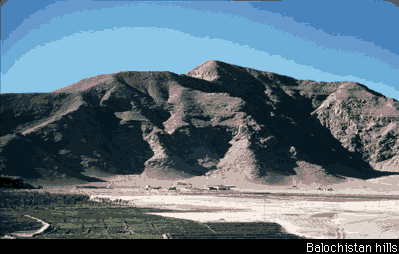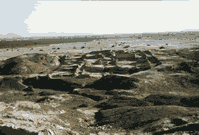| |

 Balochistan hills Balochistan hills
Early farming village cultures developed throughout the Balochistan hills after 7000 B.C. Situated geographically between the Iranian plateau and the Indus plain, the area is a natural zone for interaction between the two regions, and evidence for cultural influence from the West is found even in these early settlements.
|
| |

 Mehrgarh Mehrgarh
Mehrgarh is located at the foot of the Balochistan hills on the Kachi plain southeast of Quetta, situated strategically near the Bolan Pass. Consisting of four mounds, the site was excavated by the French team for eleven seasons between 1974 and 1985. The habitation of the site has been divided into seven periods, the first being the Pre-Pottery Neolithic period that dates to circa 7000 B.C. or even earlier. The site was abandoned between 2000 and 2500 B.C. during a period of contact with the Indus Civilization and then reused as a burial ground for some time after 2000 B.C.
Perhaps the most important feature of Mehrgarh is the fact that one can witness its gradual development from an early village society to a regional center that covered an area of 200 hectares at its height. In the course of this development, a huge platform that may reflect some form of authority was constructed at the site. Mehrgarh was also a center of manufacture for various figurines and pottery that were distributed to surrounding regions.
|







